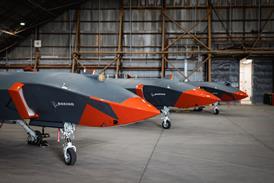Australian investigators have highlighted the importance of helicopter underwater escape training (HUET) following the crash of a Bell 204 conducting firefighting operations.
Disclosing its final report into the 20 September 2023 accident, the Australian Transport Safety Bureau (ATSB) details the pilot’s harrowing escape from the helicopter after it came down, flipped over and sank in a lake near Tarome, Queensland.

The helicopter (VH-EQW) was tasked with firefighting work, using a 1,230 litre (324USgal) water bucket carried on a 5m (16ft) line attached to its cargo hook.
After a 20min flight from a location near Amberley, the helicopter dipped the bucket into a small lake.
“As the pilot began to initiate the bucket lift, control of the helicopter was lost, and it impacted the water surface and sank,” says the ATSB, noting that the 206 flipped as it hit the water.
Although the pilot only sustained minor injuries and was ultimately able to swim to shore, his exit from the helicopter was far from straightforward.
After removing his seatbelt and helmet, the pilot was unable to open the left door with either the normal or emergency handles. He then swam to the rear of the cabin and was also unable to open the right rear door.
Kicking the windows was also unsuccessful. Only by “applying considerable force” to the left rear door was the pilot able to open it and swim to the surface.
Based on eyewitness accounts and a video, the ATSB probe determined that the water bucket’s cable had been caught over the rear part of the 204’s left skid. When the helicopter tried to ascend with the full bucket, the load shifted well outside its balance limitations, causing the crash.
“It was almost certain that as the load of water was lifted, the helicopter’s centre of gravity moved aft and left as a result of the suspension cables being caught over the skid,” says the ATSB.
“The tethered weight created an asymmetric lifting point, which resulted in a rapid loss of control and subsequent collision with water.”
The ATSB describes the value of HUET, noting that helicopters which come down in water are prone to inverting owing to the position of heavy components – the engines, transmission, and main rotors – high on the fuselage.
It says that “fear, anxiety, panic and inaction” are common responses during a helicopter accident. In-water accidents can also involve “in-rushing water, disorientation, entanglement with debris, unfamiliarity with seatbelt release mechanisms and an inability to reach open exits.”
It observes that the pilot had undergone HUET two and a half years before the accident, which “likely assisted their ability to egress the helicopter through a rear door while inverted and underwater.”


























